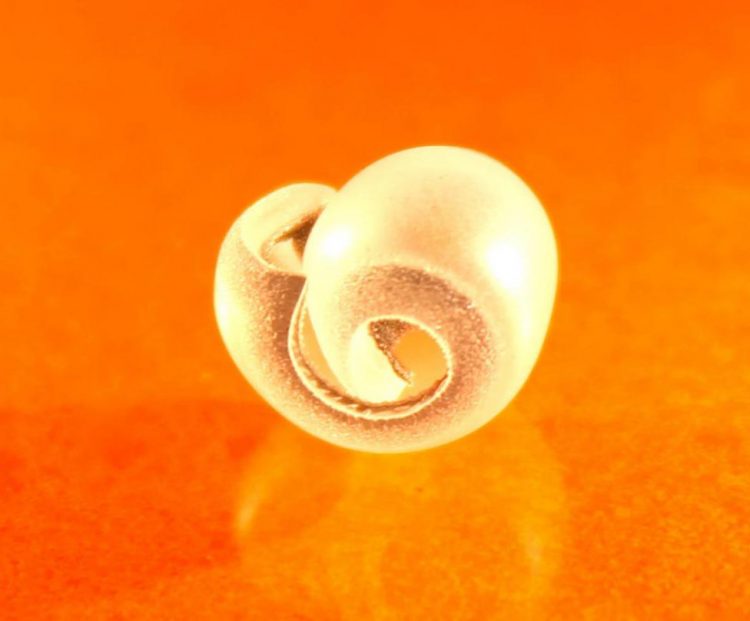Researchers use light to remotely control curvature of plastics

Researchers at North Carolina State University have developed a technique that uses light to get flat, plastic sheets to curve into shapes such as spheres, tubes or bowls. Credit: Amber Hubbard
The advance builds on earlier work by the same research team, which focused on self-folding 3-D structures. The key advance here is that rather than having the plastic fold along sharp lines — into polygonal shapes such as cubes or pyramids — the plastics bend and curve.
Researchers Michael Dickey, a professor of chemical and biomolecular engineering at NC State, and Jan Genzer, the S. Frank and Doris Culberson Distinguished Professor in the same department, were early leaders in the field of self-folding 3-D structures.
In their landmark 2011 paper, the researchers outlined a technique in which a conventional inkjet printer is used to print bold black lines onto a pre-strained plastic sheet. The plastic sheet was then cut into a desired pattern and placed under an infrared light, such as a heat lamp.
The printed lines absorbed more energy from the infrared light than the rest of the material, causing the plastic to heat and contract — creating a hinge that folded the sheets into 3-D shapes. By varying the width of the printed lines, or hinges, the researchers were able to change how far — and how quickly — each hinge folds. The technique is compatible with commercial printing techniques, such as screen printing, roll-to-roll printing, and inkjet printing, that are inexpensive and high-throughput but inherently 2-D.
But now they're using a similar approach to accomplish a very different result.
“By controlling the number of lines and the distribution of ink on the surface of the material, we can produce any number of curved shapes,” says Dickey, co-corresponding author of a paper on the self-curving plastics. “All of the shapes use the same amount of ink; it's simply a matter of where the ink is applied on the plastic.” Note: video demonstrating the technique can be seen at https:/
“Our work was inspired by nature, because natural shapes rarely incorporate crisp folds, instead opting for curvature,” says Amber Hubbard, a Ph.D student at NC State and co-lead author of the paper. “And we found that, in order to make functional objects, we often needed to use a combination of curved and folded shapes.
“Other researchers have developed techniques for creating self-curving materials, but they did this using soft materials, such as hydrogels,” Hubbard adds. “Our work is the first attempt to accomplish the same using thermoplastics — which are stronger and stiffer than the soft materials. That makes them more attractive for use in performing some practical actions, such as gripping an object.”
“The materials we're working with also hold their shape, even after the light is removed,” says Russell Mailen, a Ph.D student at NC State and co-lead author of the paper. “That's an advantage, because soft materials change shape only when exposed to a solvent, and once they are removed from the solvent they lose their shape.”
The researchers have also developed a computational model that can be used to predict the 3-D shape that will be produced by any given printing pattern.
“One of our goals is to fine-tune this model, which Mailen developed,” Genzer, co-corresponding author, states. “Ultimately, we'd like to be able to input a desired 3-D shape into the model and have it create a pattern that we can print and produce.”
###
The paper, “Controllable curvature from planar polymer sheets in response to light,” is published in the Royal Society of Chemistry journal Soft Matter and was selected by the journal to be featured on the cover. The paper was co-authored by Mohammed Zikry, the Zan Prevost Smith Distinguished Professor of Mechanical and Aerospace Engineering at NC State. The work was supported by the National Science Foundation under grants 1240438 and DGE-1252376.
Media Contact
All latest news from the category: Power and Electrical Engineering
This topic covers issues related to energy generation, conversion, transportation and consumption and how the industry is addressing the challenge of energy efficiency in general.
innovations-report provides in-depth and informative reports and articles on subjects ranging from wind energy, fuel cell technology, solar energy, geothermal energy, petroleum, gas, nuclear engineering, alternative energy and energy efficiency to fusion, hydrogen and superconductor technologies.
Newest articles

NASA: Mystery of life’s handedness deepens
The mystery of why life uses molecules with specific orientations has deepened with a NASA-funded discovery that RNA — a key molecule thought to have potentially held the instructions for…

What are the effects of historic lithium mining on water quality?
Study reveals low levels of common contaminants but high levels of other elements in waters associated with an abandoned lithium mine. Lithium ore and mining waste from a historic lithium…

Quantum-inspired design boosts efficiency of heat-to-electricity conversion
Rice engineers take unconventional route to improving thermophotovoltaic systems. Researchers at Rice University have found a new way to improve a key element of thermophotovoltaic (TPV) systems, which convert heat…



